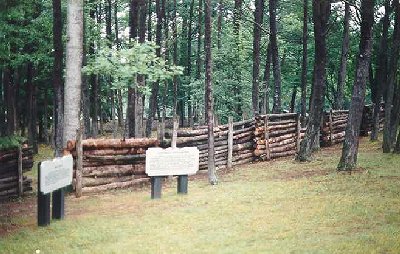
Carnifix Ferry
September 10, 1861
In the spring of 1861, a Union force under Gen. McClellan advanced deep into western Virginia, now West Virginia. Along the Kanawha, Brig. Gen. Jacob Cox pushed a Rebel force under Henry Wise out of Charleston. General Lee came to western Virginia to coordinate a counteroffensive. Lee accompanied Loring's Army of the Northwest as it attacked at Cheat Mountain while along the Kanawha, Wise's brigade was joined by Floyd's and McCausland's brigades. This Kanawha force under the command of Gen. Floyd was to advance on Charleston and the Ohio River. Three thousand Yankees held a strong position at Gauley Bridge, so Floyd crossed the Gauley River upstream at Carnifix (or Carnifex) Ferry to flank the position. The Confederates built up their forces slowly at Camp Gauley at Carnifix Ferry, allowing Gen. Rosecrans to move south from Clarksburg to the Rebel position.

Diorama
This is the diorama on display at Carnifix Ferry State Park. The flags show the Union and Confederate lines during the battle. The Patteson House and the Gauley River are also visible.

Carnifix Road
This is the original roadbed of the Carnifix Road, which passed through the Confederate line. The road is also visible in the diorama above.

Patteson House
This is the restored Patteson House which was struck by the fire of both sides as it stood between the lines.

Confederate Line
This is a reconstruction of the log breastworks which protected the Confederate defenders. The Union force lost 150 men in failed attacks on these fortifications, including at least 30 to friendly fire. Floyd lost only 20 wounded of his 5,800 men.

Gauley River from Camp Gauley
Although the Confederate position held, Floyd withdrew across the river that night and fell back toward Lewisburg. The expedition failed mostly because of the bickering between Floyd and Wise, who were pre-war political enemies. The Cheat Mountain campaign also failed, so much of western Virginia remained in Union hands.